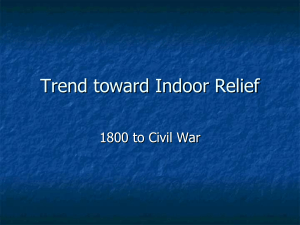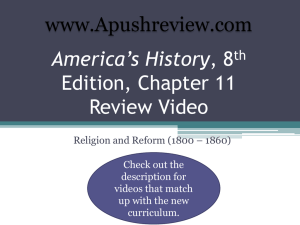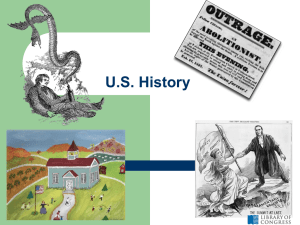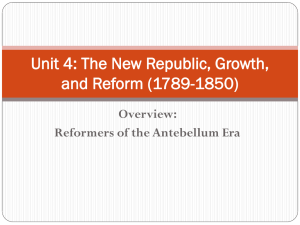Social Reforms Information
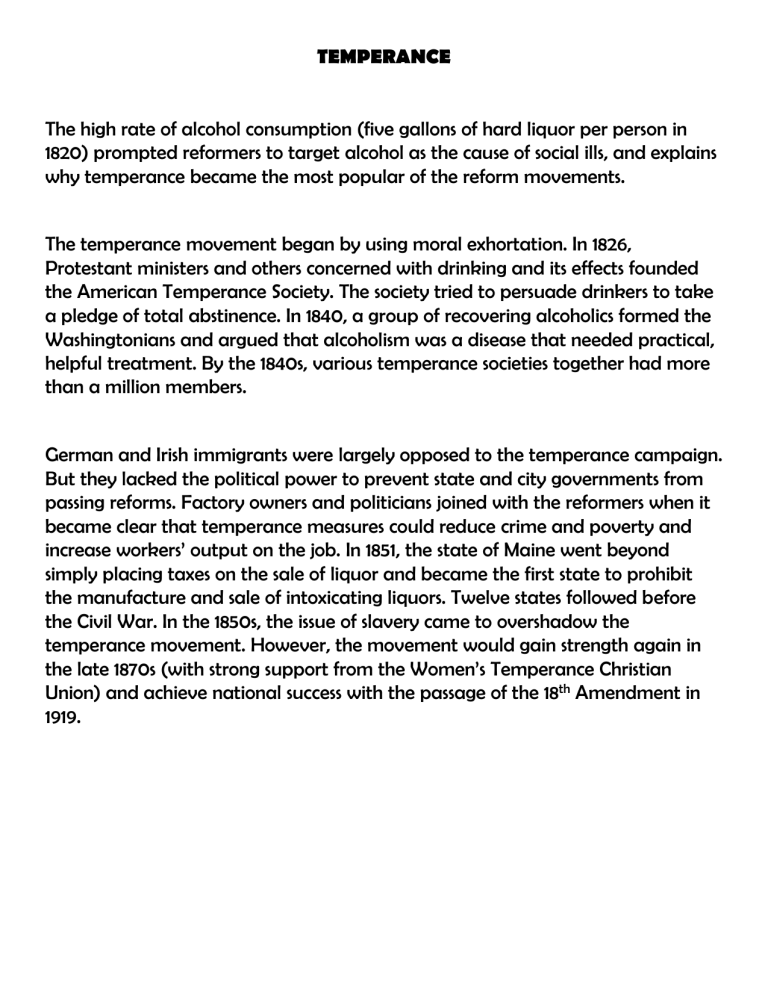
TEMPERANCE
The high rate of alcohol consumption (five gallons of hard liquor per person in
1820) prompted reformers to target alcohol as the cause of social ills, and explains why temperance became the most popular of the reform movements.
The temperance movement began by using moral exhortation. In 1826,
Protestant ministers and others concerned with drinking and its effects founded the American Temperance Society. The society tried to persuade drinkers to take a pledge of total abstinence. In 1840, a group of recovering alcoholics formed the
Washingtonians and argued that alcoholism was a disease that needed practical, helpful treatment. By the 1840s, various temperance societies together had more than a million members.
German and Irish immigrants were largely opposed to the temperance campaign.
But they lacked the political power to prevent state and city governments from passing reforms. Factory owners and politicians joined with the reformers when it became clear that temperance measures could reduce crime and poverty and increase workers’ output on the job. In 1851, the state of Maine went beyond simply placing taxes on the sale of liquor and became the first state to prohibit the manufacture and sale of intoxicating liquors. Twelve states followed before the Civil War. In the 1850s, the issue of slavery came to overshadow the temperance movement. However, the movement would gain strength again in the late 1870s (with strong support from the Women’s Temperance Christian
Union) and achieve national success with the passage of the 18 th Amendment in
1919.
MOVEMENT FOR PUBLIC ASYLUMS
Humanitarian reforms of the 1820s and 1830s called attention to the increasing number of criminals, emotionally disturbed persons, and paupers. Often these people were forced to live in wretched conditions and were regularly either abused or neglected by their caretakers. To alleviate the suffering of these individuals, reformers proposed setting up new public institutions – statesupported prisons, mental hospitals, and poorhouses. Reformers hoped that inmates would be cured as a result of being withdrawn from squalid surroundings and treated to a disciplined pattern of life in some rural setting.
Mental Hospitals
– Dorothea Dix, a former schoolteacher from Massachusetts, was horrified to find mentally ill persons locked up with convicted criminals in unsanitary cells. She launched a cross-country crusade, publicizing the awful treatment she had witnessed. In the 1840s, one state legislature after another built new mental hospitals or improved existing institutions and mental patients began receiving professional treatment.
Schools for Blind and Deaf Persons
– Two other reformers founded special institutions to help people with physical disabilities. Thomas Gallaudet opened a school for the deaf, and Dr. Samuel Gridley Howe started a school for the blind.
By the 1850s, special schools modeled after the work of these reformers had been established in many states of the Union.
Prisons
– Pennsylvania took the lead in prison reform, building new prisons called penitentiaries to take the place of crude jails. Reformers placed prisoners in solitary confinement to force them to reflect on their sins and repent. The experiment was dropped because of the high rate of prisoner suicides. These prison reforms reflected a major doctrine of the asylum movement: structure and discipline would bring about moral reform. A similar penal experiment, the
Auburn system in New York, enforced rigid rules of discipline while also providing moral instruction and work programs.
PUBLIC EDUCATION
Another reform movement started in the Jacksonian era focused on the need for establishing free public schools for children of all classes. Middle-class reformers were motivated in part by their fears for the future of the republic posed by growing numbers of the uneducated poor – both immigrant and native-born.
Workers’ groups in the cities generally supported the reformers’ campaign for free
(tax-supported) schools.
Free Common Schools
– Horace Mann was the leading advocate of the common (public) school movement. As secretary of the newly-founded
Massachusetts Board of Education, Mann worked for compulsory attendance for all children, a longer school year, and increased teacher preparation. In the 1840s, the movement for public schools spread rapidly to other states.
Moral Education
– Mann and other educational reformers wanted children to learn not only basic literacy, but also moral principles. Toward this end, William
Holmes McGuffey, a Pennsylvania teacher, created a series of elementary textbooks that became widely used to teach reading and morality. The McGuffey readers extolled the virtues of hard work, punctuality, and sobriety – the kind of behaviors needed in an emerging industrial society.
Objecting to the Protestant tone of the public schools, Roman Catholics founded private schools for the instruction of Catholic children.
Higher Education
– The religious enthusiasm of the Second Great Awakening helped fuel the growth of private colleges. Beginning in the 1830s, various
Protestant denominations founded small denominational colleges, especially in the newer western states (Ohio, Indiana, Illinois and Iowa). At the same time, several new colleges, including Mount Holyoke College in Massachusetts (founded by Mary Lyon in 1837) and Oberlin College in Ohio, began to admit women. Adult education was furthered by lyceum lecture societies, which brought speakers such as Ralph Waldo Emerson to small-town audiences.
CHANGES IN FAMILIES AND ROLES FOR WOMEN
American society was still overwhelmingly rural in the mid-19 th century. But in the growing cities, the impact of the Industrial Revolution was redefining the family.
Industrialization reduced the economic value of children. In middle-class families, birth control was used to reduce average family size, which declined from 7.04 family members in 1800 to 5.42 in 1830. More affluent women now had the leisure time to devote to religious and moral uplift organizations. The New York Female Moral
Reform Society, for example, worked to prevent impoverished young women from being forced into lives of prostitution.
Cult of Domesticity – Industrialization also changed roles within families. In traditional farm families, men were the moral leaders. However, when men took jobs outside the home to work for salaries or wages in an office or factory, they were absent most of the time. As a result, the women in these households who remained at home took charge of the household and children. The idealized view of women as moral leaders in the home is called the “cult of domesticity.”
Women’s Rights – Women reformers, especially those involved in the anti-slavery movement, resented the way men relegated them to secondary roles in the movement and prevented them from taking part fully in policy discussions. Two sisters, Sarah and
Angelina Grimké, objected to male opposition to their anti-slavery activities. In protest,
Sarah Grimké wrote her Letter on the Condition of Women and the Equality of the
Sexes (1837). Another pair of reformers, Lucretia Mott and Elizabeth Cady Stanton, began campaigning for women’s rights after they had been barred from speaking at an anti-slavery convention.
Seneca Falls Convention (1848) – The leading feminists met at Seneca Falls, New
York in 1848. At the conclusion of their convention – the first women’s rights convention in American history – they issued a document closely modeled after the Declaration of
Independence. Their “Declaration of Sentiments” declared the “all men and women are created equal” and listed women’s grievances against laws and customs that discriminated against them.
Following the Seneca Falls Convention, Elizabeth Cady Stanton and Susan B.
Anthony led the campaign for equal voting, legal, and property rights for women. In the 1850s, however, the issue of women’s rights was overshadowed by the crisis over slavery.
ANTI-SLAVERY MOVEMENT
Opponents of slavery ranged from moderates who proposed gradual abolition to radicals who demanded immediate abolition without compensating their owners. The Second Great
Awakening led many Christians to view slavery as a sin. This moral view made compromise with defenders of slavery difficult.
American Colonization Society – The idea of transporting freed slaves to an African colony was first tried in 1817 with the founding of the American Colonization Society. This appealed to moderate anti-slavery reformers and politicians, in part because whites with racist attitudes hoped to remove free blacks from US society. In 1822, the American Colonization Society established an African-American settlement in Monrovia, Liberia. Colonization never proved a practical course. Between 1820-1860, only about 12,000 African-Americans were settled in Africa, while the slave population grew by 2.5 million.
American Anti-Slavery Society – In 1831, William Lloyd Garrison began publication of an abolitionist newspaper, The Liberator , an event that marks the beginning of the radical abolitionist movement. The uncompromising Garrison advocated immediate abolition of slavery in every state and territory, without compensating the slaveowners. In 1833, Garrison and other abolitionists founded the American Anti-Slavery Society. Garrison stepped up his attacked by condemning and burning the Constitution as a pro-slavery document. He argued for “no Union with slaveholders” until they repented for their sins by freeing their slaves.
Liberty Party – Garrison’s radicalism soon led to a split in the abolitionist movement. Believing that political action was a more practical route to reform than Garrison’s moral crusade, a group of northerners formed the Liberty Party in 1840. They ran James Birney as their candidate for president in 1840 and 1844. The party’s one campaign pledge was to bring about the end of slavery by political and legal means.
Black Abolitionists – Escaped slaves and free African Americans were among the most outspoken and convincing critics of slavery. A former slave such as Frederick Douglass could speak about the brutality and degradation of slavery from firsthand experience. An early follower of Garrison, Douglass later advocated both political and direct action to end slavery and racial prejudice. In 1847, he started the anti-slavery journal The North Star . Other African
American leaders, such as Harriet Tubman and Sojourner Truth, helped organize the effort to assist fugitive slaves escape to free territory in the North or to Canada, where slavery was prohibited.
Violent Abolitionism – David Walker and Henry Highland Garnet were two northern African
Americans who advocated the most radical solution to the slavery question. They argued that slaves should take action themselves by rising up in revolt against their owners. In 1831, a Virginia slave named Nat Turner led a revolt in which 55 whites were killed. In retaliation, whites killed hundreds of African Americans in brutal fashion and put down the revolt. Before this event, there had been some anti-slavery sentiment and discussion in the South. After the revolt, fear of future uprisings as well as Garrison’s inflamed rhetoric put an end to anti-slavery talk in the
South.


